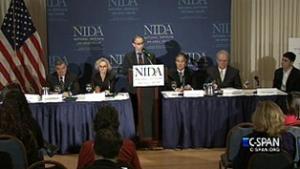This year's annual Monitoring the Future (MTF) survey on the habits of 8th, 10th, and 12th graders was released Wednesday, and most of the results were uncontroversial. But with two states having already legalized marijuana for adults and opinion polls suggesting more and more Americans are ready to move ahead with legalization, battles are raging over the numbers on teen marijuana use and what they mean.

Drugs where teen use levels were stable included LSD; amphetamines; Adderall, specifically; Ritalin, specifically; ecstasy; cocaine; crack; heroin; methamphetamine; crystal methamphetamine; sedatives; tranquilizers; Rohypnol; Ketamine; and steroids. For most of these drugs, use levels even in 12th grade were quite low. For instance, 2.2% of seniors reported using LSD, 2.3% reported using Ritalin, and 4.0% reported using ecstasy.
When it comes to marijuana, 23% of seniors said they smoked in the month prior to the survey, 18% of 10th graders did, too, and so did 12% of 8th graders. Some 6.5% of seniors reported daily use, as did 4.0% of 10th graders, and under 2% of 8th graders.
It helps to put those numbers in historical perspective. All of the numbers are above the historic lows in teen drug use reported at the end of the Reagan-Bush era in the early 1990s, but well below the historic highs in teen drug use reported in 1979, just before the Reagan-Bush era began.
For seniors, the all-time low for monthly use was 11.9% in 1992, but the recent high was 23.1% in 1999. This year's 22.7% is actually a decline of two-tenths of a percent from 2012, and in line with figures for the past decade showing rates hovering in the upper teens and low twenties. It's a similar story at the younger grade levels.
The survey also found that the notion that regular use of marijuana is harmful is losing favor among teens. Only 39.5% of seniors saw it as harmful, down from 44.1% last year, and down significantly from views over the past two decades.
Despite the relative flatness of the marijuana use numbers, some warned that the sky is falling, cherry-picking the numbers and warming to favored themes to support their points of view.

"These increases in marijuana use over the past few years are a serious setback in our nation's efforts to raise a healthy generation of young people," said Gil Kerlikowske, director of the Office of National Drug Control Policy. "Teens deserve to grow up in an environment where they are prepared to meet the challenges of the 21st century, and drug use never factors into that equation. Today's news demands that all of us recommit to bolstering the vital role prevention and involved parenting play in keeping young people safe, strong, and ready to succeed."
"This is not just an issue of increased daily use," said Nora Volkow, director of the National Institute on Drug Abuse (NIDA). "It is important to remember that over the past two decades, levels of THC -- the main psychoactive ingredient in marijuana -- have gone up a great deal, from 3.75% 1995 to an average of 15% in today's marijuana cigarettes. Daily use today can have stronger effects on a developing teen brain than it did 10 or 20 years ago."
Volkow also latched onto figures showing that 12% of 8th graders had tried marijuana in their lives.
"We should be extremely concerned that 12% of 13- to 14-year-olds are using marijuana," Volkow added. "The children whose experimentation leads to regular use are setting themselves up for declines in IQ and diminished ability for success in life."
In 2012, MTF added questions about where students obtain marijuana. In states that have medical marijuana, 34% of pot-smoking seniors said one of the ways they got their marijuana was through someone else's prescription (recommendation). And 6% said they got it with their own recommendation.
"A new marijuana industry is forming in front of our eyes, and make no mistake about it: they are delighted their customers -- today's youth -- consider their product safe," remarked former Congressman Patrick J. Kennedy, a Project SAM cofounder. "The rise of legalization and medical marijuana has sent a message to young people that marijuana use is harmless and non-addictive."
But while the drug czar, Dr. Volkow, and Project SAM were sounding the tocsin about the threat of teen marijuana use, others reacted more calmly, taking solace from the findings that teen cigarette smoking and drinking, not to mention other drugs, had declined.
"These findings should put to rest any claims that reforming marijuana laws and discussing the benefits will somehow contribute to more teens using marijuana," said Mason Tvert, director of communications for the Marijuana Policy Project. "It's time for prohibition supporters to stop hiding behind teens when debating marijuana policy."
The declines in teen cigarette smoking and drinking show that regulation -- not prohibition -- is the way to address substance use, Tvert said.
"Regulation clearly works and prohibition has clearly failed when it comes to protecting teens," he argued. "Regulating alcohol and tobacco has resulted in significant decreases in use and availability among teens, and we would surely see similar results with marijuana. At the very least, this data should inspire NIDA and other government agencies to examine the possibility that regulating marijuana could be a more effective approach to preventing teen use."
This work by StoptheDrugWar.org is licensed under Creative Commons Attribution-ShareAlike 4.0 International
Comments
Self-Reported?!
https://trucchiclashroyalesite.wordpress.com/2016/06/23/gemme-infinite-clash-royale/
teen drug use
Marijuana has become " boring " to teens . They seem to prefer the pharmaceuticals these days . Along with the meth . The forbidden fruit of Cannabis is no longer so forbidden . Anyone can grow a plant . Therefore , they move on to more enticing adventures . Drug Prohibition at its best . Make it readily available and easy to get and the teens loose interest . Remember when you were 13 ? ...
Bear in mind that this
Bear in mind that this so-called "study" was conducted and so-called "statistics" were obtained during a time of national marijuana prohibition, and is therefore all the more reason to Legalize, Tax, and Regulate Marijuana Nationwide!
What message are we send sending our children when it is easier for them to obtain marijuana now with it being illegal than it is for them to buy alcohol?
It doesn't take the intellect of a genius to understand that stores card kids for I.D..Thugs and gang members do not. They also push the real hard drugs on children. Stores do not.
Marijuana legalization will make it harder for children to obtain it.
What message does it send our children when the President of The United States himself alongside a long list of successful people openly admit regular pot use at one time or another in their lives?
While we tell our kids how it will ruin their futures, and then ensure so, by allowing our government to to jail our children and give them permanent criminal records when they get caught with a little Marijuana? Especially if they are the wrong skin color or from the "wrong neighborhood". Which in turn, ruins their chances of employment for life.
The Prohibition of Marijuana is the wrong message to send our children while we advertise and promote the much more dangerous use of alcohol like it's an all American pastime.
The worst thing about marijuana and our children is what happens to them when they get caught up in the criminal justice system due to it's prohibition. .
Protect our Children! Through the Legalization and Regulation of Marijuana Nationwide!
Dr. Volkow got the numbers wrong
Dr. Volkow's potency numbers are wrong. It's sad to see someone who's supposed to be the fed's voice of science in the drug policy debate mislead so badly, especially when the numbers are available.
According to the University of Mississippi's Potency Monitoring Project - which has the federal contract to carry out that research, based on seized samples from feds, states, and locals - in 1995, commercial-grade non-domestic (imported) cannabis averaged 3.95% THC, and non-domestic sinsemilla-type cannabis averaged 9.64%. Domestic commercial-grade cannabis averaged 2.55%, and domestic sinsemilla-type cannabis averaged 7.26% THC.
There's a reason she chose 1995: In 1996, commercial-grade non-domestic (imported) cannabis averaged 4.41% THC, and non-domestic sinsemilla-type cannabis averaged 11.30%. Domestic commercial-grade cannabis averaged 2.90%, and domestic sinsemilla-type cannabis averaged 8.94% THC. And in 1997, commercial-grade non-domestic (imported) cannabis averaged 4.93% THC, and non-domestic sinsemilla-type cannabis averaged 12.02%. Domestic commercial-grade cannabis averaged 3.34%, and domestic sinsemilla-type cannabis averaged 11.50% THC.
In 2000, non-domestic commercial grade marijuana averaged 5.10% THC. The non-domestic sinsemilla type averaged 12.87%. Domestic commercial grade marijuana averaged 3.96% THC, and domestic sinsemilla type averaged 12.72%.
In 2010, non-domestic commercial grade marijuana averaged 6.69% THC. Non-domestic sinsemilla type averaged 12.81% THC. Domestic commercial grade marijuana averaged 2.79% THC, and domestic sinsemilla type averaged 11.84%.
The Project's quarterly reports are actually hard to come by, but the White House's annual National Drug Control Strategy has a data supplement, which has a table listing the Project's estimated cannabis potencies starting back in 1985.
Unfortunately, according to a footnote on ONDCP's 2013 table, the Project stopped testing domestic samples, 2010 was the final year for that though they do continue to test non-domestic samples, which is why I used those figures. The numbers don't seem to be outliers, though having said that, domestic sinsemilla had had much lower averages for a few years prior to 2010, and 2010's domestic estimates were based on fewer samples than in previous years, so it's tough to say.
The bottom line is, her numbers were wrong, and it was deliberately misleading. Why that matters, is because Dr. Volkow is not just another hack politician, she's not an uninformed blogger, she's a respected psychiatrist with a long executive career and for the past 10 years she has been the Director of the National Institute on Drug Abuse. Her official public comments are supposed to be fact-based, not idle chatter.
That table btw is reproduced in Drug War Facts at http://www.drugwarfacts.org/cms/Marijuana#THCTable
Add new comment